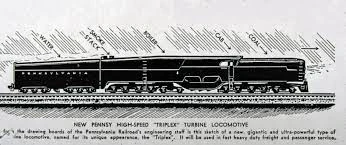This is what is available from the major locomotive builders as of 2024 in the world of the Three Amigos. Of course, this is just for North America, as the export market for most of these makers would go for pages and pages.
Electro-Motive Diesel
Parent Company: General Motors
Headquarters: McCook, Illinois, USA
Assembly Facilities: McCook, Illinois, USA; Eddystone, Pennsylvania, USA; Zamora, San Luis Potosi, Mexico; London, Ontario, Canada
Engine and Component Manufacturing: Cleveland, Ohio, USA; Flint, Michigan, USA; Eddystone, Pennsylvania, USA; St. Catharines, Ontario, Canada; Rancho Nuevo, San Luis Potosi, Mexico
Four-axle Diesel-Electric: GP70AC-T4, GP75MAC-H, F125 "Spirit" [1]
Six-axle Diesel-Electric: SD70MX-2A, SD70ACe-T4, SD70ACe-XC, SD89ACe-T5, SD90MAC-H, SD95MAC
Eight-axle Diesel-Electric: SD89ACe-BB, SD90MAC-BB [2]
Four-axle Electric: AEM-10B
Six-axle Electric: PS21B-V3, PS22C, GM24 "Vision"
Six-axle Switcher: MP40AC
Four-axle Road Slug: PS6RS
High-Speed Train Set: X 4000VA [3]
GE Transportation
Parent Company: General Electric
Headquarters: Fort Worth, Texas, USA
Assembly Facilities: Erie, Pennsylvania, USA; West Colton, California, USA; Fort Worth, Texas, USA; Empalme, Sonora, Mexico; Loretito, Aguascalientes, Mexico; Peterborough, Ontario, Canada
Engine and Component Manufacturing: Grove City, Pennsylvania, USA; Tucson, Arizona, USA; Acaponeta, Nayarit, Mexico; Blainville, Quebec, Canada
Four-axle Diesel-Electric: P45AC "Genesis II"
Six-axle Diesel-Electric: EST44AC, EST44C4, EST60ACi, EST80ACi [4]
Eight-axle Diesel-Electric: EST80ACBi [5]
Six-axle Electric: E84C, E80C
Ten-axle Electric: EP70-V2U [6]
Six-axle Switcher: PH26ACi
Gas Turbine-Electric: TS150-VT4
High-Speed Train Set: HS4-12, HS4-16
American Locomotive Works
Parent Companies: Chrysler Corporation, Emerson Electric, Cummins
Headquarters: Schenectady, New York, USA
Assembly Facilities: Schenectady, New York, USA; Roseville, California, USA; Montreal, Quebec, Canada;
Engine and Component Manufacturing: Lansing, Michigan, USA; Columbus, Ohio, USA; Ferguson, Missouri, USA; Belvidere, Illinois, USA; Airdrie, Alberta, Canada
Four-axle Diesel-Electric: Millennium 245DPI
Six-axle Diesel-Electric: Millennium 250DP, Millennium 260DP, RF70LCe, RF80LCe [7]
Eight-axle Diesel-Electric: RF80LB2e [7]
Six-axle Electric: Millennium 275EP
Four-axle Switcher: Millennium 255GS
High-Speed Train Set: 500NA Series, 900 Series [8]
MK Rail
Parent Companies: Morrison-Knudsen, Stadler Rail
Headquarters: Boise, Idaho, USA
Assembly Facilities: Boise, Idaho, USA; Salt Lake City, Utah, USA; Sacramento, California, USA
Engine and Component Manufacturing: Sacramento, California, USA; Bethlehem, Pennsylvania, USA; Vancouver, Washington, USA
Four-axle Diesel-Hydraulic: DH24V [9]
Four-axle Diesel-Electric: MP40PH-4C, MP54AC, HSP50, Stadler 4000 [10]
Six-axle Diesel-Electric: MK6000C-2e, MK6500C-2e
Four-axle Electric: AEM-12B [11]
Six-axle Electric: AEM-15C
[1] Carbody unit meant for commuter service and operating in non-electrified areas for passenger service.
[2] These are designed for Brazilian railroads and are designed for 5'6" track gauge, but EMD has a 4'8.5" version available for North American customers if they want to order it.
[3] These train sets are built by EMD under license from ABB and Kalmar Verkstad
[4] The EST80ACi is a 7500-horsepower diesel electric using a 20-cylinder version of the GEVO engine
[5] Built originally for China Railways, but as Chinese and North American railroad standards are nearly identical, these are available for North American customers to purchase if they wish
[6] The EP70-V2U is a two-unit articulated electric locomotive with a C-B-C truck arrangement, meant for heavy-hauling operations
[7] The RF "Railfreight" series of diesels are hood units built by Alco to complement the carbody-styled Millennium Series of locomotives. Both are very similar mechanically, both using Cummins OSK series engines and Emerson electrical components. The RF80LB2e is the biggest single-unit locomotive offered in North America at 83'6" in length and with the largest single-unit diesel ever produced by Cummins, the 24-cylinder, 7800-horsepower QSK142
[8] Alco has been joined at the hip in its high-speed train efforts since the 1980s with Kawasaki Heavy Industries, and while the 500 Series Shinkansen has been mostly retired in Japan they are highly popular in North America and remain in service, while the 900 Series is an Alco-KHI development based on many of the design clues of the Fastech 360 experimental trains
[9] The DH24V is a Vossloh Modula design, adapted for the North American market and available with a variety of powertrains
[10] The Stadler 4000 is the Vossloh Euro 4000 Passenger locomotive design, operated by Amtrak, Via Rail Canada, Auto-Train and Rocky Mountaineer Railtours
[11] This is a passenger-electric design developed by Morrison-Knudsen using Swiss electrical components, aiming to replace aging AEM-7ACs in Amtrak and NdeM service
I'll finish the Siemens, Bombardier, Caterpillar and Brookville units in a future post.

 locomotive.fandom.com
locomotive.fandom.com
